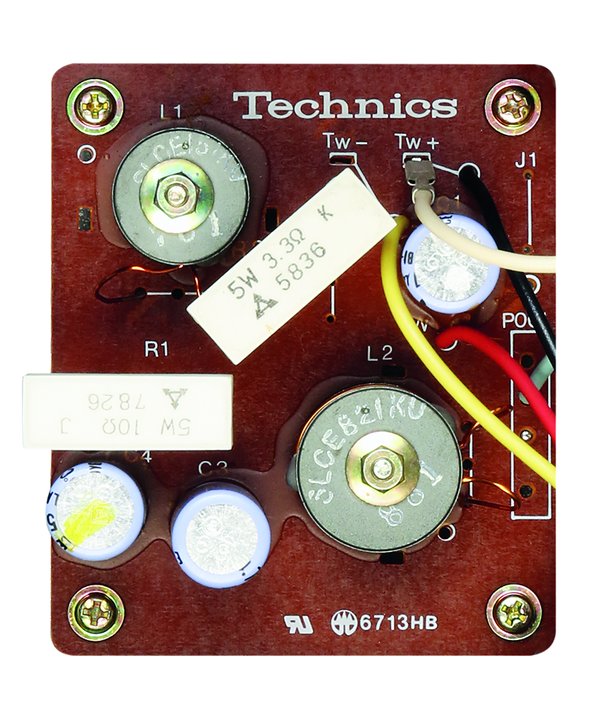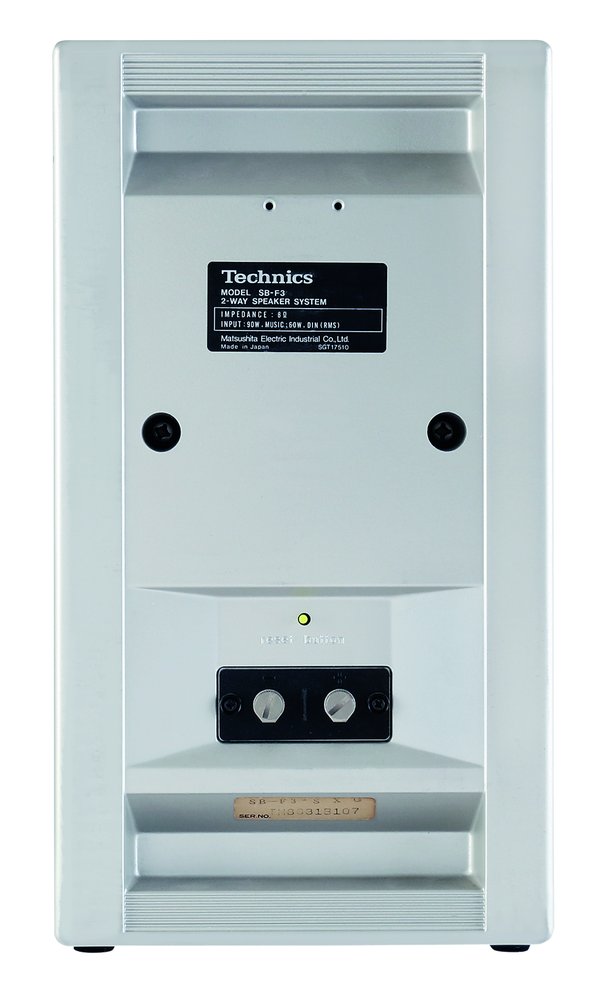Technics SB-F3 Loudspeaker

 Largest of a trio of bookshelf speakers featuring diecast alloy cabinets and horn-loaded tweeters, Technics’ SB-F3 was a true high-tech compact. How does it fare today?
Largest of a trio of bookshelf speakers featuring diecast alloy cabinets and horn-loaded tweeters, Technics’ SB-F3 was a true high-tech compact. How does it fare today?
The smallest speaker in Technics' three-strong F series has already featured in our Vintage Review section . It was a popular product and sold in decent numbers for something that could have easily been mistaken for a mere novelty. Less well remembered were the larger members of the same family, the SB-F2 and SB-F3. Neither of these was exactly 'large', but the SB-F3 was certainly too big to be considered a miniature model like the SB-F1. It was, instead, in the class of conventional compact loudspeakers intended for shelf or stand placement, a sector where the number of competing models was far greater.
The external dimensions of the SB-F1 were all expanded by around 50% for the SB-F3. The weight doubled and power handling went up from a nominal 60W to 90W. Rated sensitivity improved from 86dB to 89dB/1W/1m [see PM's Lab Report, p125], as would be expected for the increases in cabinet volume and cone area. The price nearly doubled too, from £88 to £160 (excluding VAT).
These are the bare facts, but under the skin, matters were a little more complicated. Potential problems with resonances in the metal walls of a cabinet multiply as their areas are expanded, and this meant that careful design was required to maintain the expected sound quality.
 All components, including the PCB, in this 2nd-order/3kHz crossover are made by Matsushita
All components, including the PCB, in this 2nd-order/3kHz crossover are made by Matsushita
Prime Time
The 'F1 and 'F3 still had many points in common though. Both featured pressure die-cast alloy enclosures made in two pieces that were secured with long bolts running from the back to the front. Both were pressure-chamber designs with rubber O-rings used to seal the joint between the cabinet halves. Both models were also two-way speakers and employed a woofer of advanced design allied to a miniature horn-loaded tweeter set well back in the cabinet for optimum time alignment.
This led to a claim in both cases of phase linearity - an important area of study within the Technics organisation at the time following the launch of the company's first 'phase linear' speaker, the SB-7000 . Finally, both were produced almost entirely from parts designed and made by Matsushita (the parent company of Technics and at one time the largest producer of CE products in the world) in Japan. Only the most mundane of elements, such as fixings and wire, were bought in. The drive units, the cabinets and all the components in the crossovers were specifically made for this application, their characteristics and performance being tailored to achieve the desired performance. Arguably, aside from Philips it is difficult to think of another company that would have been capable of doing this.
One advantage of this approach was that the drive units could be built to work with the cabinet (and each other) in such a way that only a minimal crossover circuit was required. For the SB-F3 this meant a modest three capacitors, two inductors and two resistors, all made by Matsushita. Cabinet resonances were damped by bonding 5mm rubber sheets to the inside surfaces and the tops of the cabinets, and by casting deep features and additional bracing into the rear.
 The SB-F3’s cabinet is a two-part die-cast affair, the sidewalls damped
with sheets of rubber and braced with a polymer rod. The crossover [see p120] is mounted at the top rear of the cabinet
The SB-F3’s cabinet is a two-part die-cast affair, the sidewalls damped
with sheets of rubber and braced with a polymer rod. The crossover [see p120] is mounted at the top rear of the cabinet
Seal The Deal
Further damping was provided by a hard rubber rod bonded horizontally between the centre of each cabinet side and by the action of the O-ring seal between the cabinet front and back. Conventional wadding was also used, carefully held in place by further features within the cabinet. Finally, a thermal circuit breaker was fitted to protect the woofer from being overloaded or otherwise damaged by the partnering amplifier.
To match these cabinets the drive units were also suitably high-tech. The 160mm woofer used an aluminium voice coil and an anti-resonant metal centre cap. Designed for the SB-F3, and never used elsewhere, it was assembled with special polyamide adhesives and utilised polyurethane roll edges. The tweeter was a 19mm metal dome set at the back of a small horn made up of three pieces (the horns of the SB-F1 and SB-F2 were formed from just two pieces). The action of this was augmented by a conical recess cast into the front panel of the cabinet, which would become a signature part of the appearance of these models.
 Rear view shows screw cable connections best suited to spade terminations. The thermal cut-out (reset button is visible above cable terminals) offers fairly crude protection for the woofer only
Rear view shows screw cable connections best suited to spade terminations. The thermal cut-out (reset button is visible above cable terminals) offers fairly crude protection for the woofer only
Purist Perils
The downside to these purist methods of construction was that the development and tooling costs were very high. This was less of a problem for Technics with its slick international marketing operation and large cohort of fanatically loyal customers, but all the same, the SB-F3 proved less popular than the SB-F1. The range was current from 1978 until 1984 but when it came time to introduce a replacement only the SB-F1 and SB-F2 were retained. There was no SB-F3 Mk II but the Mk II SB-F1 and SB-F2 remained in the catalogue until 1991.
Just as with the SB-F1, the SB-F3 has a feel of quality. There are no shabby and faded cloth grilles and there is no peeling plastic wood or tatty veneer. The back is finished as well as the front so they can be placed far out into the room without looking unsightly. Where many loudspeakers are simply glued-together wooden boxes the F series models are precision engineered and a joy to inspect.
Even though they are the largest model in the range, the 'F3s are still far from full-sized and being sealed boxes (ie, not ported) they are easier to place. Well stocked bookshelves are ideal, but failing that, placing them on moderately tall stands in the corners of a reasonably cosy (small!) listening room is a good place to start. A partnering amp in the 40 to 75W class makes a good match, but the surprisingly high sensitivity of these speakers means lower-powered models are not out of the question. Remember, though, that tweeters in particular are more easily damaged by an under-powered amp than one that produces too much output.
Connections are by screw terminals that are designed to be adjusted with a coin - a normal screwdriver will just chew up the slots. Ideally, your cables should have forked ends (spades) attached to them - beware loose strands if you choose to clamp to bare wire ends.
 Largest of the F series speakers marries a 160mm pulp bass/mid cone (type EAS-16PL144S) with a horn-loaded 19mm alloy treble dome (type EAS-7HH02SA)
Largest of the F series speakers marries a 160mm pulp bass/mid cone (type EAS-16PL144S) with a horn-loaded 19mm alloy treble dome (type EAS-7HH02SA)
Tim Listens
The larger size of the SB-F3 when compared to the SB-F1 promises better performance, particularly in the bass. This state of affairs brings problems of its own - it is easy to forgive the SB-F1 all manner of shortcomings (not that it has that many) because it is so small. The SB-F3, on the other hand, must compete with hordes of similarly-sized loudspeakers on equal terms. Sounding like a slightly bigger SB-F1 is just not enough to win it full approval, but the SB-F3 still wins out with a performance that's both deeper and more detailed.
What is clear is that the SB-F3s can move a lot more air, and move it further without getting into difficulties. This translates into a larger scale, more vivid listening experience. True, this speaker is no SB-7000, but it represents a useful step closer to concert realism than the SB-F1s can provide. The chief drawback of the SB-F1 was its indifferent projection of stereo images when used for purposes other than nearfield monitoring. The SB-F3 does much better in this respect, creating a soundstage that can boast width and depth that's clear to hear.
As with every other Technics speaker of this era that I've heard, it's the tweeter's performance that makes the SB-F3 a worthwhile listen. The sound is bright and hard edged, but not unpleasantly so. The bass sounds hardly any more extended than that of the SB-F1, but it appears more natural and less forced. There is an immediacy to the delivery of the music that makes listening to orchestral works really exciting - it is like you are sitting right in the front row. The key here is to get the volume setting just right - loud enough to be realistic but not so loud that all you can hear are those instruments that appear to be positioned right in front of you.
A Bigger Bang
Handel's Music For The Royal Fireworks [Deutsche Grammophon 447-279-2] was an absolute treat when heard through these loudspeakers. The tiny tweeters brought the strings into perfect focus, even if they did occasionally sound a tad fizzy around some of the brass and woodwind. Though tonally not especially neutral I did find that the SB-F3 captured the brilliance and pace that live music has in a way that many larger and more complex speakers miss.
Processed music from the studio revealed another aspect to the sound. The synthetic bass lines in Everything But The Girl's 'Wrong' [Walking Wounded; CDV2803] lacked extension at first, but the crisp, high-definition presentation made it easy to mentally fill in the bass and instead enjoy the low-end precision that only seems to come from well engineered small loudspeakers like these. All the same, careful positioning was required to avoid the bass sounding too dry and boxy - some reinforcement is required from the surroundings. Yet perhaps the real surprise was the vocal clarity the SB-F3 can produce. Had this been a blind test I could have easily mistaken them for a three-way design in this respect as there's no impression of there being a midband presence dip.
Is any of this enough though? Unlike the SB-F1, the SB-F3 isn't hi-fi you can hold in the palm of your hand and neither does it shock or startle you when you first hear it. Its attractions lie at a deeper level: the needle-sharp focus, tight bass and immaculate standard of finish. Owners of top-end Japanese micro systems need to hear these speakers but others should consider them too. They would be just the ticket for injecting some sparkle into an otherwise dull sounding set-up.
Buying Secondhand
The SB-F3 is well made and durable but there are still some things to look out for. The versions sold in Japan and those made for export are built to a slightly different specification and are voiced to suit local tastes - something to bear in mind if a tidy pair turn up for sale in downtown Osaka. Also be aware of amateur modifications - different crossover components, the removal of the protective meshes over the drive units and big ugly binding posts drilled into the back are all quite common. None can be considered an improvement.
The polyurethane roll edge of the woofer is longer lasting than the foam rubber sort but can split if the speaker has been left somewhere hot. The various aftermarket edges don't really suit these units; if they are in poor condition try and find a better woofer from a scruffy donor. The same applies to the tweeter, if it gives a rattly or grating sound a replacement is best sourced from another loudspeaker. Finally, the SB-F5 it isn't part of this series. It's a basic conventional design intended for low cost packaged systems.
Hi-Fi News Verdict
Why make a larger version of a speaker whose appeal came down to its very small size? Well, the SB-F3 demonstrated that the principles behind this classic design were scaleable. If you like a bright and sharply delineated sound from a speaker capable of delivering music with real immediacy then these high-tech-looking blasts from the past are well worth seeking out. And they are still fairly plentiful too.
Sound Quality: 88%


















































